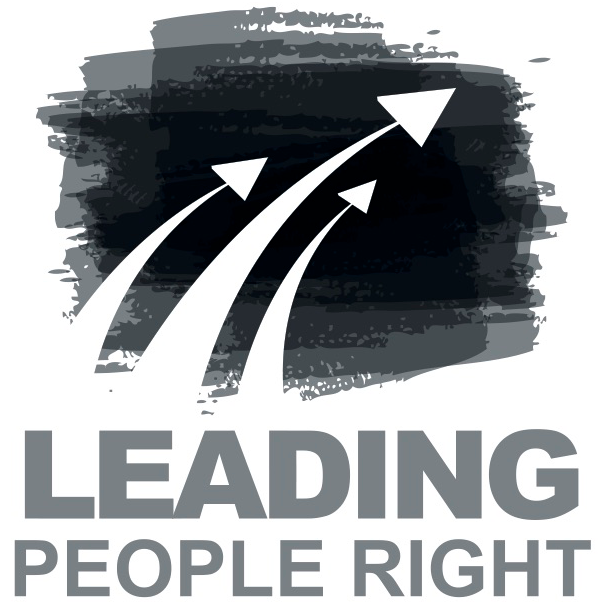How do people describe you? Their answer is your personal leadership brand as they see it. People around us have their perception and we have a sense of self. We don't often pause on the gap between the two. Understanding that open space is critical to being effective as a leader and helps guide personal development. Mind the gap!
Actively managed or not we each have one – a personal leadership brand that is
“Your brand is what people say about you after you have left the room.”
Amazon founder Jeff Bezos coined this super simple definition for a brand.
Few realities are more foundational to success as a leader than knowing how people experience you. You need to understand it as best you can, shape it and engage in open dialogue with those you lead.
People are talking about it, so you best get on it!
If you are short on time here is a printable, shareable PDF of this post. Click here.
A New Sheriff In Town
Several years ago a new Division President was announced for our business. Translation, I had a new boss…again! Each transition to a new leader came with the promise of a better way forward. As always with these things, you never know where it leads.
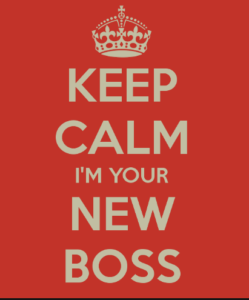
The new President’s entry into the business was both instructive and personally impactful. It was because he was entirely intentional in sharing who he was and what he expected. He did so first by providing and then talking with his direct reports about his personal leadership brand statements.
It was a first for me. These statements included what was important to him, what he wanted to be known for and expected of us.
Inspiration Came Knocking
The approach may seem obvious for an incoming leader. However few leaders take the time to reflect on these questions adequately, catalog them and share with their team and key internal partners.
It was both what he delivered and how he delivered it. He offered the insights without ego and with a strong servant leader orientation.
He inspired me to carry the approach forward. When I completed the statements and shared with them, it brought me closer to individuals on my team, helped ground me for difficult times and provided a qualifying filter for future hiring. Finally, it helped me chart a course for my leadership development work.
You may be wondering, did it help or have any impact on the business? There are always many influences, but I’m thrilled to have been part of several teams each delivering excellent growth and businesses better positioned for the future.
The work on leadership brand was an essential underpinning for me to stay grounded and on course serving the group.
So Why Is This Personal Leadership Brand Stuff Important?
The way people experience you every day has a direct connection to how effective you will be with:
- Communicating
- Influencing
- Persuading
- Collaborating
- Teaching
- Coaching
- Motivating
- Negotiating
- Building trust
Yes, a list of leadership essentials. As you see ‘how people experience you’ guides your ability to do so many things that ultimately determine success or failure.
Additionally, understanding your leadership brand provides a professional you are here. The gap between how you are versus how you want to be viewed is fertile ground for your leadership development work. It precisely clarifies what actions, habits, and attributes you should focus your growth efforts.
As Yogi Berra said:
If you don’t know where you are going, you end up somewhere else.
What This Is And Isn’t
Isn’t:
This topic for some conjures up brand in the context of an online presence. Much of what you see when you search personal leadership brand is just that. I get the importance but first things first. It makes sense to consider after you have squared up how the essential people in your world see you.
Is:
Leadership brand is relevant to regardless of formal role or title. Clarity on how you people experience you is essential for anyone that wants to thrive and grow their influence.
Related Post: Why The Best Leaders Empty Their Cup First

Let’s Get Started
Here are five steps for to help you think through and build your leadership brand statements:
1. Review actual versus intent
The starting point for all of this:
- Do you know what people say about you?
- How does it compare to how you see yourself?
- Is this what you want to be known for?
2. Catalog notable leadership influences
Think about people and their behaviors that inspire you, influence you, make you bristle or even repel you?
3. Reflect on your values
How do you describe your core values? What is non-negotiable for you? What’s most important for people to know about you as a leader?
4. Assess how you operate
What informs your leadership style, skills and how you present to your team. A few questions to help :
- How do you actively use or manage your strengths and weakness?
- What are your preferences for getting input; for communicating 1:1, groups, peers, your manager?
- Where do you fall on the spectrum of light or heavy handed with people?
- What is your connection to the business of your business – customers, growth and operational issues?
- What situations bring out the best and worst in you, and what you can do to improve?
- Are you experiencing the 9 Things People Do If They Want You To Be Successful?
5. Consider your ability to adapt to change
What are you doing to keep up with a changing work environment and the world?
(Be mindful – if you aren’t experiencing some discomfort or even pain, you likely aren’t growing. Yes, it’s exactly like trying to get in shape!)

Some Truth-Telling About Self-Assessment
Most people think they are great drivers and listeners and yes, self-aware. Ah-hem, we all know this is not the case!
In her book “Insight – Why We’re Not As Self-Aware As We Think And How Seeing Ourselves Clearly Helps Us Succeed At Work And Life,” Tasha Eurich does a user-friendly deep dive into this topic.
Setting the stage for where we are on self-awareness, Ms. Eurich’s research reveals:
Even though most people believe they are self-aware, only 10-15% of the people we studied actually fit the criteria.
Ouch.
Some headlines from her work from an article summarizing it What Self-Awareness Really Is And How To Cultivate:
- There are two components. Internal self-awareness refers to how well we know ourselves. External self-awareness means how well we understand the way others view us. People with high self-awareness focus on both dimensions.
- Years of experience and accumulated power often yield overconfidence and work against self-awareness.
- Introspection doesn’t correlate with increased self-awareness. It leads to excess negative thoughts and ruminating.
So with some myths busted on self-awareness, what should you do? The advice is to:
- Work on internal and external self-awareness.
- Focus on what versus why questions (such as those above).
- Engage the truth tellers in your world.
My encouragement is not to wait for it to come to you or the ultra-formal approach (e.g., 360 assessments). Push into the work of self-assessment knowing the harsh reality that 1) most of are not and 2) with a receptive mind.
Also, check out the quiz – Insight Quiz – How Self-Aware Are You. If you and someone you trust both complete it, you get a short report back from her organization. Interesting stuff.
Bringing It All Together
Here are the 4 Leadership brand statement pillars I recommend you distill and channel your thinking through:
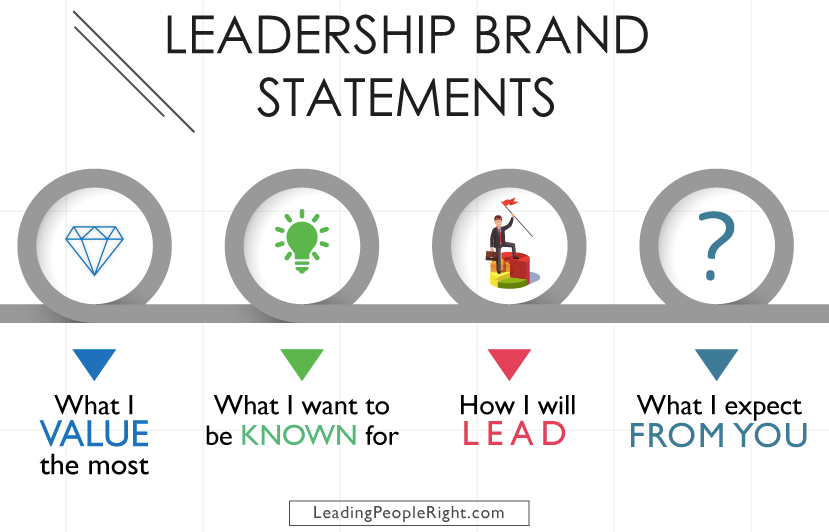
A few guiding principles as you craft your statements:
- Be real – brand statements must sound like and reflect who you are
- Brevity is your friend – a few short bullets for each area will help people on board the information
- Make an impact – words matter, pick ones that help people get what you mean and how it matters to you.
- Seek out your truth tellers – get real feedback as you think through the above and on your draft statements.
Click here for my Leadership Brand Statements
These are my actual statements. Hopefully, they can serve both as an example for you and the document a template to help you capture and communicate your work.
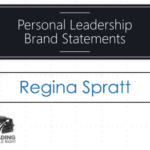
Hang On A Second – It Sounds Like It Is All Rosy
When you ask someone – so how would people describe yourself – infrequently do they give you any negative attributes. On some level, that’s ok. Most people aren’t expecting a list of negatives.
On the other hand lack of awareness on what can derail you and what negative perceptions people have, doesn’t cut it. Negative brand attributes are part of the gap between where you are and where you want to be.
It takes conscious action and again your truth tellers to help you see a clear picture. Confirm the gaps.
The Big Reveal For Your Personal Leadership Brand Statements
Once you have completed your work, it’s time to share. Reviewing with your team is a critical next step. It makes this real like nothing else.
As with the Division President in the story I told, you are providing a means for them to understand you and a foundation to work together successfully. Ideally, they hear your desires around authenticity, open communication, trust building and team unity.
Also, they serve as a witness to your accountability to be consistent with a set of values and behaviors.
Learn to understand how other people interpret your behaviors. If you are misunderstood, change the behavior.
— Guy Harris (@recovengineer) March 13, 2018
When Does This Make Sense
Doing this leadership brand statement work is very helpful when you move into a new to a role. It is a solid jumping off point for you as the leader and your team. You get to know each other. You can address any ambiguity that exists for people at the front end of new leadership assignments.
It is also valuable for almost anyone to do this. Think back to the original question — Is Your Leadership Brand Actually What You Want?
If you don’t know — aren’t sure — haven’t done this in a while, the time figuring it out is well spent. There is almost no scenario where closing the gap between — where you want to be and where you are with how people view you — isn’t a good idea.
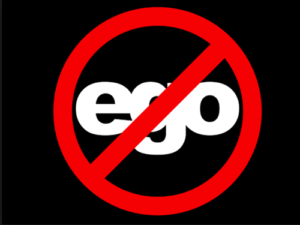
Ego And Vulnerability
First, let’s talk about ego. Some will struggle more than others to reveal your strengths and weaknesses. You need to push through regardless of whether you are having trouble admitting the positive or the negative. “What I value most” and “What I want to be known for” are neither boastful or telling tales you wouldn’t want to say.
Second, let’s hit on vulnerability. Yes, sharing this information may be uncomfortable. It may feel like you are putting yourself out there. You are — but it is more than worth it. The trust and personal “equity” you build with your team by doing this pay a dividend.
It’s impossible to talk about the concept of vulnerability without referencing professor and researcher Dr. Brene Brown. Among many things, Dr. Brown explains that vulnerability is not weakness, it is demonstrating courage. Says Brown:
Courage is when you tell the story of who you are.
That is EXACTLY what you are doing!
(Do yourself a favor if you haven’t seen her Listening To Shame TED Talk, watch it. I can almost guarantee the Teddy Roosevelt man in the arena quote will stay with you!)
Looking Forward From The ‘You Are Here’
As mentioned, your work here and the personal leadership brand statements help set the table for your leadership skill development going forward.
Three areas to explore further:
Go deeper into self-assessment (with the above comments in mind):
This is your baseline after all. There are various assessment options and leadership style assessment instruments out there. You likely have resources within your organization to assist. Also, consider whether you identified and tapped into the truth tellers fully during this process. We all need them.
Sketch out a living, breathing development plan:
There is often more talk than reality with personal development plans in the corporate world. We each own our development and will need to drive the execution.
Identify how you will narrow the gap (between where you are and what you want to be known for). Include leadership behaviors and the associated habits you need to build along with specific leadership skills you want to develop.
Less is more. Have a short but meaningful list at any one time.

Don’t Go It Alone
Engage a coach, a mentor, a friend but don’t go it alone. It is so helpful to think out loud with someone, get pushback or pushed when it’s warranted. Make sure it’s someone you trust – meaning both you and they speak the truth.
Refresh
Periodically review and re-calibrate your leadership brand statements along with your development plan. Your growth, new challenges and the pace of change all suggest a regular review and refresh is appropriate.
Professional ROI
If you can’t answer the question ‘how do people experience me’ – you are leaving to chance – is it what you think and want. The work here is an investment you make in yourself and your team.
The rewards are real and sustainable:
- For your team, and as I experienced, you provide invaluable information, insights and maybe even a little inspiration.
- For you, you identify a road you can pave and be proud to travel
Next post we’ll look at what people see when they observe you — and they are!
Question: What do you do to ensure you understand your personal leadership brand?
Click here for my Leadership Brand Statements. These can serve as an example for you and the document a template to help you capture and communicate your work.
For a printable PDF of this article. Click here.
Additional Reading: Six Faces Of Your Leadership Brand
